Not Sleeping Well? Check the Temperature of Your Room
Almost a third of Americans do not get enough sleep, managing fewer than 6 hours of shut eye per night. The trend of national sleep deprivation is worrying, as it can affect physical and mental health leading to poor concentration, memory loss, mood swings, and weight gain. There are several factors that affect sleep quality, and one of the most important is getting the right room temperature for a better sleep. It may surprise you to learn that a good bedroom temperature induces sleep and will help you get the rest your body needs. Of course your geographical location can play a role as well.
Set Your Thermostat
To achieve the right room temperature, ensure that your thermostat is working properly and regulate the heat or coldness of your sleeping area. Smart thermostats can even be programmed with your smart phone, automatically setting to a certain temperature when it’s bed time. Sleep experts believe that the best room temperature should be around 65°F. As you fall asleep, your body temperature drops and then rises slightly as morning approaches. If the room is too hot or cold, it can interfere with the sleeping process and can make you restless.
It is also a good idea to use a room thermometer so that you have a better overview of what is happening in your bedroom. Adjust the thermostat as needed, monitor if there are fluctuations, and experiment with the best setting for a comfortable sleep. Some people may sleep better in higher or lower temperature settings, it’s really up to you to see which one suits you the best.
Check Your Bedding and Pillows
Bed linen and pillows also affect your quality of sleep. The type of fabric, for example, can generate heat or keep you cool during warm days. Cotton and linen are great in keeping you fresh and cool, while synthetic fabrics do not absorb moisture and are ideal when humidity levels are high. Think of investing in organic, wool-filled bedding, such as pillows or comforters. The material will absorb humidity and wick the moisture away from your body. Woolen bed linens will also help you keep cool, control moisture levels, and prevent your body from overheating.
Add Plants to Cool a Room and Maintain Humidity
Plants not only add beauty to a room, they also release moisture into the atmosphere through a process called transpiration that can help lower temperatures. Temperatures can decrease by as much as 10 degrees if there are plants in the room, according to a USDA study. In addition to cooling a room, the moisture released by plants assists in maintaining indoor humidity. The human comfort zone is around 30-60% of indoor humidity. A room with a comfortable level of humidity and temperature can stimulate better sleep.
Good bedroom temperatures play a role in getting a quality snooze. By regulating your thermostat, using breathable bed linen, and adding plants, you can set the temperature of your bedroom for a better sleep.






